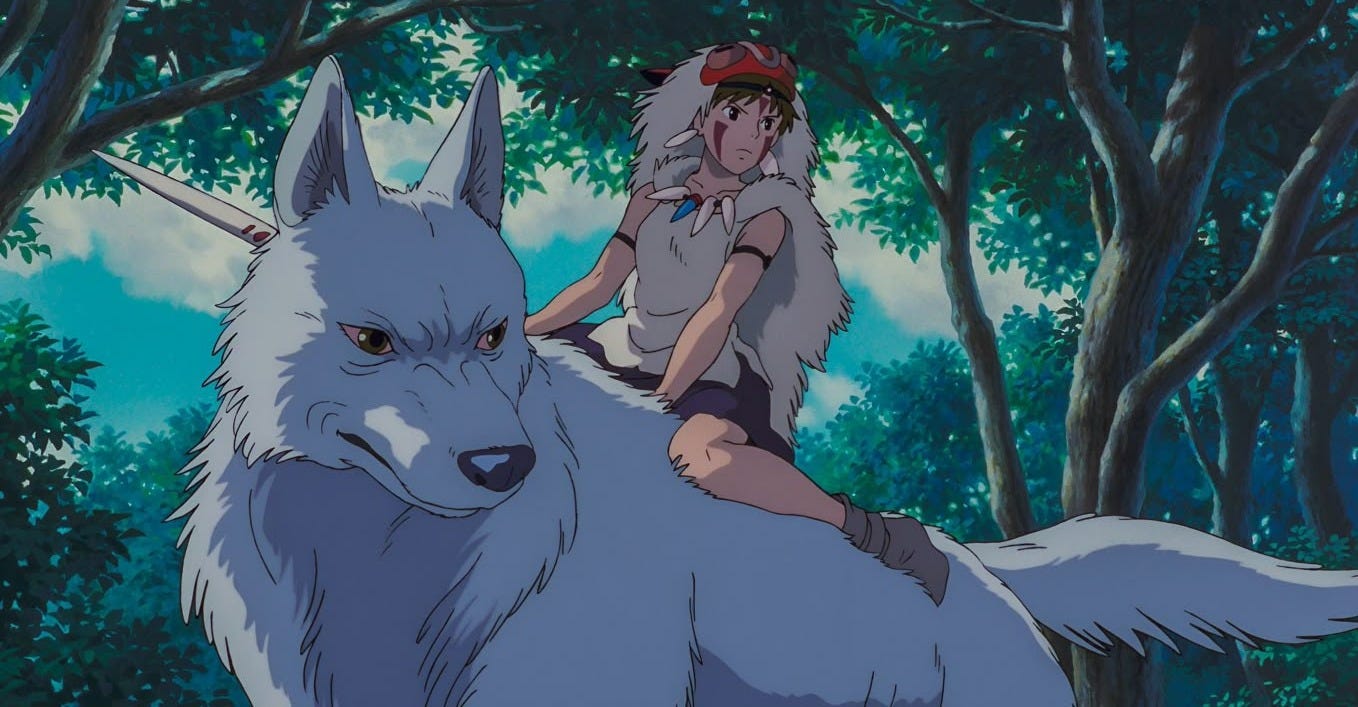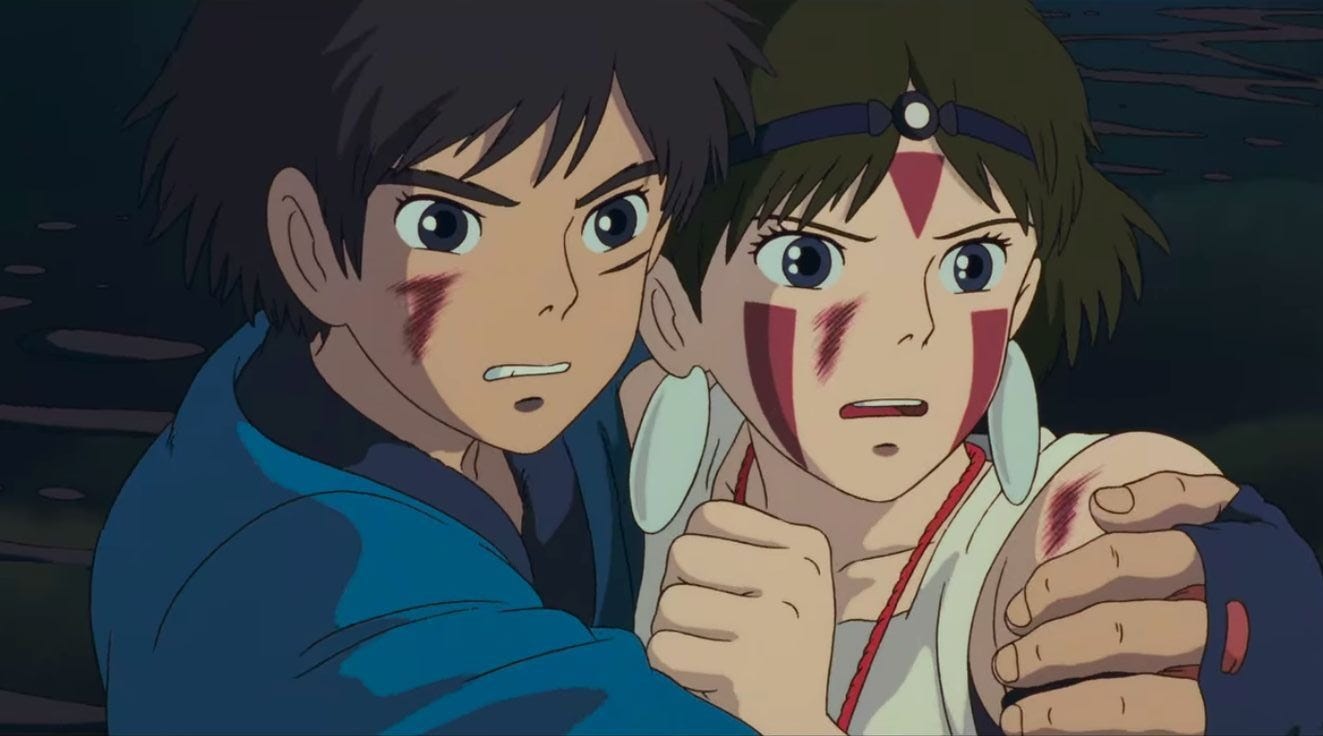"Princess Mononoke" and its defying portrayal of gender roles
For my favorite movie in Ghibli universe
Man is not ruled by forces alone, but also by ideas. In the modern era, the media proves its role in reflecting, reinforcing, and sometimes challenging the values of gender embedded within society. I will analyze how the movie “Princess Mononoke” - written and directed by legendary Japanese animator Hayao Miyazaki from Studio Ghibli - challenged the traditional perceptions of Japanese women.
The traditional gender binary is a social and cultural framework that categorizes individuals into two distinct genders: male and female. It’s worth pointing out that while the terms “sex” and “gender” are sometimes used to substitute for each other, they are not interchangeable. “Sex” is a multidimensional biological construct based on anatomy, physiology, genetics, and hormones, whereas “gender” can be broadly defined as a multi-dimensional construct that encompasses gender identity and expression, as well as social and cultural expectations about status, characteristics, and behavior as they are associated with certain sex traits (“Sex and Gender”). Put simply, sex is biologically coded and gender is socially and culturally constructed which indicates that it can be learned and unlearned. The relationship between biological bodies and the performances of genders can be seen in the way that men are often labeled as physically superior, emotionally stoic, and aggressive, and women as physically inferior, emotionally supportive, and passive.
To understand how “Princess Mononoke” breaks gender’s traditional molds, let’s take a brief look at the context of Japan. The government initiated the “Cool Japan” program, officially called the Intellectual Property Strategic Program, focused on promoting Japanese popular culture on a global scale. This initiative emerged amidst Japan's declining manufacturing competitiveness which was aimed to shift the emphasis towards intangible intellectual products and content-based export industries, such as anime, manga, game software, and cinema (Laura Miller, 98). Socially, the “Cool Japan” campaign presents a gendered portrayal of Japanese culture that favors traditional femininity and prioritizes male-centric interests, offering a limited and arguably prejudiced representation of both genders, in which women are portrayed as cute, weak, submissive, and dependent on males (Laura Miller, 102). Such ideologies of “Cool Japan” can be easily found in mainstream anime.
Against the trends of popular anime, “Princess Mononoke” by Hayao Miyazaki takes a different approach to representing women. “Princess Mononoke” is set during the Ashikaga period, precisely during the period of the Onin War that occurred between 1467 and 1477, which saw a greater production of iron. The story follows Ashitaka, a young prince from the Emishi tribe, who becomes cursed after slaying a boar demon corrupted by hatred and iron. Seeking a cure for the curse, Ashitaka heads west to uncover the origins of the demon's anger and the spread of human destruction in the natural world. Ashitaka arrives at Iron Town, led by the ambitious Lady Eboshi, who seeks to expand her iron production by clearing forests and battling the nature spirits. Her actions have enraged the forest gods and spirits, including San - Princess Mononoke herself and also a human girl raised by wolves. Caught in the middle, Ashitaka attempts to mediate between the humans of Iron Town and the forest spirits. He befriends both sides: San, who distrusts him at first but later sees his compassion, and Lady Eboshi, whose actions, while destructive, also uplift marginalized people, such as lepers and former prostitutes. As tensions escalate, a climactic battle unfolds involving Iron Town, the forest gods, and a neighboring lord seeking power. In the end, Ashitaka and San acknowledge their differences but choose to respect each other's worlds, with Ashitaka staying to help rebuild Iron Town and San returning to the forest. The movie ends on a bittersweet note, highlighting hope for balance and coexistence.
The film portrays female characters who are empowered to pursue their ambitions without restriction. The film opens with Ashitaka, who is cursed after a battle with a demonic boar. He seeks guidance from Hi-sama, the village's wise woman, who advises him to leave the village to find the curse's source. As the community's authority, Hi-sama's knowledge is unquestioned. Ashitaka's immediate departure without further inquiry highlights her influence and the respect she commands.
Ashitaka proceeds to meet Lady Eboshi, a prominent figure in Iron Town - the leader who earns the respect and obedience of the villagers. Her influence is significant, and they follow her orders without questioning her authority. This respect is earned through her actions, as she fearlessly led the defense of Iron Town against attacks from the forest spirits. While Eboshi's actions have a destructive impact on the forest, she also plays a role in rescuing women from prostitution and providing them with employment opportunities in Iron Town. She also offers a chance for those suffering from leprosy. This compassionate side of her character is deeply respected by the townspeople, who are willing to go to great lengths for Iron Town's prosperity.
Lady Eboshi - aggressive, ambitious, and work-oriented thus defies the traditional expectation of a woman in a Japanese Confucian society that emphasizes patriarchy and underestimates working women. Since its introduction to Japan in the 6th century, Confucianism has significantly shaped social organization and continues influencing Japanese gender roles in modern society. Confucianism emphasizes a family-centric structure with men traditionally holding leadership roles and women expected to rely on them (Born, 39). The ideology reinforces the “good wife, wise mother” (ryosai kenbo) concept in Japan, which dictates that women should prioritize their roles as homemakers and caregivers, dedicating themselves to the well-being of their families and the upbringing of their children, particularly their sons who would grow to devote to the country’s development. There is even a Japanese term "oniyome" (devil wife), used to describe married women who choose to work outside the home. In other words, women are expected to prioritize domestic duties over career aspirations. Such belief remains prevalent in Japanese society, as while the country has made great political, economic, and technological breakthroughs, it only ranks 118th in the 2024 Gender Gap Report, still far worst among G7 group. And the figure of Lady Eboshi is exactly opposite to that of an ideal Confucian woman. In another scene, a group of men boast to female ironworkers about risking their lives to provide for their families and demand respect. The women swiftly challenge this claim, pointing out that they are the ones who produce the iron that finances these meals. Both Lady Eboshi and these female characters defy the traditional submissive roles often ascribed to Japanese women.
Another “untraditional” female character in the movie is San - a beautiful young woman who is fierce and aggressive by nature thanks to her upbringing by wolves. This wild side drives her to protect the forest and its spirits by driving out humans. She fearlessly ventures into Iron Town alone to confront Lady Eboshi. Yet, beneath her tough exterior, she shows compassion, as evidenced by her care for Ashitaka after he is injured while helping her escape. Compared to other teenage figures in major animes, San is more independent, mature, and strong, both physically and mentally. In Japan, it’s common to witness an anime that portrays teenagers as cute, vulnerable, and demanding protection - the damsel in distress archetype in Japanese animation. As Kaori (2009) indicates, Japanese women are popularly portrayed as “victims”, relegated in a patriarchal society where women continue to submit to “social and cultural norms’ and ‘institutions that deprive them of the pursuit of their aspirations”. Hence, the figure of San unconventionally defies the dominant ideology of a teenage girl in Japanese society.
It’s worth noticing that, in the movie, the male protagonist - Ashitake has to mediate the conflict between the humans of Irontown and the forest spirits. While there are hints of a potential romantic relationship between Ashitaka and San, their primary focus is on restoring harmony between humans and nature. Romance in “Princess Mononoke” serves as a secondary plot element, suggesting that even with a potential romantic connection, the story largely focuses on themes of environmentalism. This is part of a larger trend in Studio Ghibli films to portray women as capable and independent, challenging traditional Japanese gender roles. Women, through Hayano Miyazaki’s lens, don’t need love and romance to define themselves and strive for growth, self-discovery, and personal aspirations instead. Ghibli’s rival in the West - Disney takes the opposite approach when it comes to portraying women. Early Disney princesses like Cinderella and Snow White follow traditional fairy tale patterns, portraying women as helpless characters who need male heroes for rescue and happiness (Eva Strnadová, 22). The portrayal of female characters in “Princess Mononoke” marks a breakaway from common notions of gender roles found in Western films, as they display traits of strength and leadership commonly thought to be found in a masculine figure (Olowu, 05).
In conclusion, Princess Mononoke challenges the traditional gender binary prevalent in Japanese culture by portraying women as strong, independent female characters who actively shape their destinies and challenge social norms. The film defies the expectations of female characters in anime and Japanese society, where women are often depicted as submissive, dependent, and passive. By doing so, Princess Mononoke offers a more progressive representation of women, inspiring audiences to question and re-evaluate traditional gender roles.
REFERENCE
Born, C, “In the Footsteps of the Master: Confucian Values in Anime and Manga”, in, ASIA Network Exchange: A Journal for Asian Studies in the Liberal Arts, vol. 17, 2010, no. 2, p. 39.
Eva Strnadová. Identification and Analysis of Japanese Cultural Aspect in Ghibli’s Anime Adapted From British Novels. 2022, p. 22 theses.cz/id/yn82bd/Strnadova_Bachelor_theses.pdf?stahnout=1;dk=tGcehies.
Kaori H., Okano. Young Women in Japan: Transitions to Adulthood. Routledge, 2009.
KYODO NEWS. “Japan Ranks 118th in 2024 Gender Gap Report, Still Far Worst Among G7.” Kyodo News+, 12 June 2024, english.kyodonews.net/news/2024/06/d578aaf9c1f4-japan-ranks-118th-in-2024-gender-gap-report-still-far-worst-among-g7.html.
Laura Miller. “TAKING GIRLS SERIOUSLY IN ‘COOL JAPAN’ IDEOLOGY.” Japan Studies Review: Interdisciplinary Studies of Modern Japan, vol. 15, 2011, pp. 98, 102, asian.fiu.edu/jsr/miller-taking-girls-seriously.pdf.
Olowu, Karen '14, "Deconstructed Gender Norms in Princess Mononoke" (2013). 2013 Fall Semester. Paper 5, p. 5. http://digitalcommons.imsa.edu/fall2013/5
“Sex and Gender.” National Institutes of Health, 5 Nov. 2024, orwh.od.nih.gov/sex-gender#ref-2-foot.







Tri thức quá thảo nào suốt ngày trong thư viện